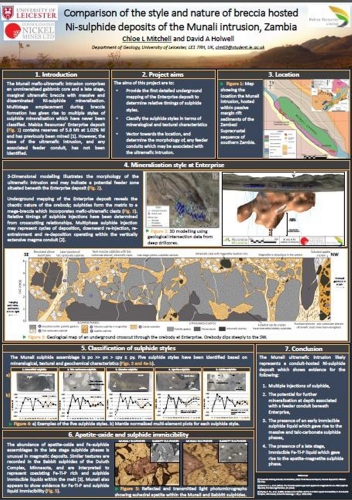MICROMINE’s Academic Licensing Scheme (ALS) continues to assist students with industry based learning and on the job skills by partnering with the University of Leicester in 2016 and beyond.
As a participant in MICROMINE’s ALS, University of Leicester students have been granted access to MICROMINE’s namesake solution, Micromine for their studies and research, including the integration of the software in a bespoke exploration techniques course. Fourth year student Chloe Mitchell put Micromine to use in her Master’s project ‘Comparison of the style and nature of breccia-hosted Ni-sulphide mineralisation within the Munali intrusion, Zambia’ and consequently Miss Mitchell won this year’s Mineral Deposits Study Group (MDSG) student poster prize at the Annual Winter Meeting in Dublin in January 2016.
Miss Mitchell used Micromine’s Implicit Modelling functions to predict the location of the feeder zone of the intrusion, which could hold additional resource potential. “Micromine was really useful for determining the morphology of the ultramafic intrusion surrounding the Munali gabbro. I was looking for any indication that the feeder zone to the ultramafic intrusion might be located beneath the Enterprise mine, so I inputted the drillhole data into the drillhole database and used the lithological intersections to show where the ultramafic intrusion was beneath the surface, I think the model shows the potential feeder zone really well” said Ms Mitchell.
By using logged lithology intervals from drill core as the input to Micromine’s Lithology Implicit Modelling function, she was able to obtain a 3D solid model of the mineralised ultramafic portion of the intrusion. From this 3D model, Ms Mitchell was able to identify a potential feeder zone and thus suggest an area for further exploration. “I chose implicit modelling because I wanted to create surfaces from lithological boundaries in the drillhole data and I had read that this was the best way to do so. Also, the implicit modelling tool was really easy to locate and follow, and I was able to experiment until I had created a shape that I was happy with” commented Ms Mitchell.
Miss Mitchell chose to use implicit modelling over traditional methods because the morphology of the intrusion was not immediately obvious in 2D sections and also, in a short time-frame the implicit modeller gave her an opportunity to experiment with a range of parameters until she had a suitable shape for the intrusion.
With just a small amount of training and exposure to the software, Miss Mitchell was able to generate 3D solid models for her project, demonstrating the intuitive nature of Micromine. When asked what Micromine features and benefits she found most useful, Miss Mitchell said, “Generally, just how user-friendly the programme is, and how I managed to navigate my way around it having done the Micromine module that the University of Leicester offers. Micromine helped me a lot to visualise it in 3D and present the data in a way that other people could also see the shape of the orebody clearly.”
Dr Dave Holwell, Senior Lecturer in Applied and Environmental Geology at the University of Leicester, runs the third year course that uses Micromine and supervises Miss Mitchell’s project. “We have been using Micromine in our teaching now for three years, to unanimously positive feedback from students about its user-friendliness and the chance to develop industry-relevant technical skills. Chloe taught herself how to do the implicit modelling, which again in testament to its ease of use, and has been supported by Micromine staff, and we are looking forward to seeing the final results of this really exciting project.”
MICROMINE would like to congratulate Miss Mitchell on an excellent project and MDSG poster prize.
About MICROMINE:
MICROMINE is a leading provider of intuitive software solutions for the exploration and mining sector. MICROMINE’s integrated suite of solutions covers the entire mining process, from exploration through
to mine production.
MICROMINE understands the software and consultancy needs of operations around the world. Located in the world’s major mineral producing capitals, our teams are close to clients’ operations.
This means MICROMINE can provide local support in the client’s own language and time zone.
University of Leicester:
The University of Leicester is a leading UK University that was founded in 1921. A University of 23,000 students, Leicester delivers high quality undergraduate, postgraduate and professional education and is committed to international excellence through the creation of world changing research.
The Department of Geology at Leicester is well known for its high quality teaching and strong fieldbased approach. Geology at Leicester is consistently ranked as one of the top 10 departments in the UK, and has strong international links with industry and academia. It offers MGeol and BSc degrees in a variety of subjects including Geology, Applied and Environmental Geology, Geology with Geophysics, Geology with Palaeobiology, and a joint degree in Geography-Geology. All of its programs are modular and provide degree-specific optional modules in the third and fourth years.